Applied Physics

As has been predicted for some time, there is a physics train wreck coming at the semiconductor industry - a size and speed where atoms have reached their limits. Quantum computing has remained a dream for 20 years with little progress, which means chips will have to start getting bigger again, to get better performance - or we settle for playing Angry Birds.
The present size and speed limitations of computer processors and memory could be overcome by replacing silicon with phase-change materials, which are capable of reversibly switching between two structural phases with different…

Can sound vibrations replace pesticides? Researchers are adapting different eco-friendly methods to try and boost harvests and open up a new chapter in sustainable farming.
Scientists in Northern Italy are experimenting with what they call eco-friendly sound and odor devices to fight off insects from their cultivated fields., though environmental activists don't accept the science of pesticides that have passed registration for 40 years and genetic modification almost as long so believing they will consider sound vibrations friendly is a stretch.
But their studies suggest that these methods…
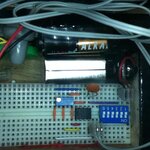
A tone generator is a useful piece of test equipment used, for example, to test the frequency range of audio equipment such as your stereo or the external speakers for your iPod. A tone generator can also be used to tune a musical instrument such as a guitar. You can make a simple tone generator using a 555 Timer IC, a capacitor, potentiometer, speaker, and a power source (circuit pictured above). Here’s the schematic:
If this circuit seems familiar to you, it might be because of this previous blog post. Talkingelectronics.com used my picture and only slightly modified it with digital…

Researchers have used sound to communicate with an artificial atom, demonstrating phenomena in quantum physics using sound rather than light.
The interaction between atoms and light has been studied extensively but making acoustic waves couple to an artificial atom is a newer endeavor. An artificial atom is an example of such a quantum electrical circuit. Just like a regular atom, it can be charged up with energy which it subsequently emits in the form of a particle. This is usually a particle of light, but the atom in the Chalmers experiment is instead designed to both emit and absorb energy…

When researchers created a whipped jet in polydimethylsiloxane oil, a viscous dielectric material, they were surprised to see the chaotic motion switch over to a steady-state helical structure.
So they got a high-speed, microscope-based video camera operating at 50,000 frames per second to study the waveforms emerging from the experimental jets, which were less than five microns in diameter. The resulting video allowed precise examination of the waveforms produced when the liquid flowed out of the glass needle and into the second liquid flowing around it.
Working with collaborators…
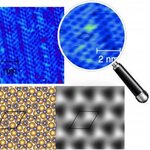
The 2-D material germanene, a 'cousin of graphene', is made up of just a single layer of germanium atoms and is expected to exhibit impressive electrical and optical properties.
Germanene was first proposed in 2009 but remained elusive. Since then, graphene has been developed further and other 2-D materials, such as silicene, have been synthesized. Much like silicene, the proposed method for synthesising germanene is to deposit individual germanium atoms onto a substrate under high temperatures and in an ultra-high vacuum.
The breakthrough by the European research team was made in parallel…
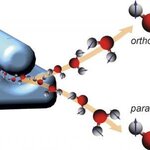
At first glance, water seems to be a simple molecule because a single oxygen atom is bound to two hydrogen atoms - but it is more complex when taking into account hydrogen's nuclear spin, a property reminiscent of a rotation of its nucleus about its own axis.
The spin of a single hydrogen can assume two different orientations, symbolized as up and down. So, the spins of water's two hydrogen atoms can either add up, called ortho water, or cancel out, called para water. Ortho and para states are also said to be symmetric and antisymmetric, respectively.
Fundamental symmetry rules…
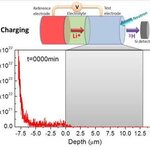
Using a neutron beam, researchers at The Ohio State University have able to track the flow of lithium atoms into and out of an electrode in real time as a battery charged and discharged, providing a kind of window into the inner workings of a lithium-ion battery for the first time.
They believe that neutron depth profiling (NDP) could one day help explain why rechargeable batteries lose capacity over time, or sometimes even catch fire.
They are using the technique to test new, high-capacity electrode materials, including ones containing tin, silicon, germanium and aluminum. These alternative…
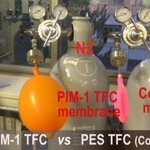
Greenhouse gases, originating from natural sources, industrial processes and the burning of fossil fuels, are the culprits behind current global warming fears. The most abundant among them is carbon dioxide, which made up 84% of the United State's greenhouse gases in 2012, and can linger in Earth's atmosphere for up to a thousand ears.
Countries all over the world are looking to reduce their carbon dioxide footprint but carbon dioxide is essentially a waste product with little immediate commercial value and large treatment costs. New low-cost technologies will be needed to incentivize…

Keeping upright in a low-gravity environment is not easy and nothing shows that more than by how often NASA has documented astronauts falling on the lunar surface.
A new paper suggests these moon mishaps might be common because its gravity isn't sufficient to provide astronauts with unambiguous information on which way is "up".
Using a short-arm centrifuge provided by the European Space Agency, the international team simulated gravitational fields of different strengths, and used a York-invented perceptual test to measure the effectiveness of gravity in determining the perception of up.
The…